Center for Biomedical Engineering and Science
From its beginnings, collaboration was the fundamental element to success for the UNC Charlotte bioengineering program. Working in shared laboratory and office spaces, engineers and biologists combined their knowledge and talents to develop outstanding interdisciplinary research and academic programs.
The first biomedical faculty member the Mechanical Engineering Department hired was Russ Keanini. He helped recruit Robin Coger as the second mechanical engineering member of the group and Mark Clemens as a biology member in 1996. Mechanical Engineering Professor Charles Lee joined the group in 1999, having come from the University of California at Berkeley. He became director of the UNC Charlotte Center for Biomedical Engineering and Science in 2011.
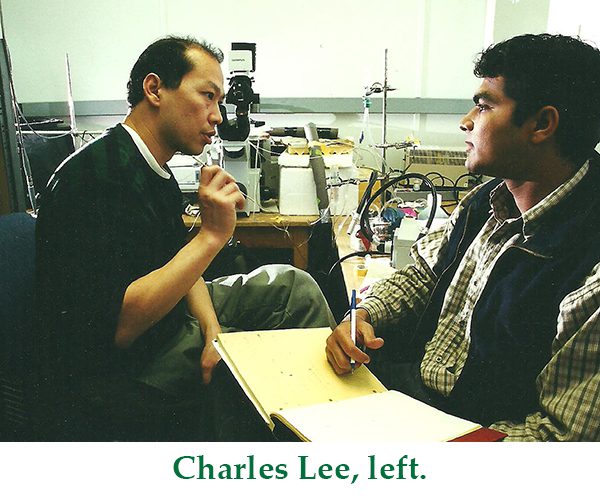
“Russ, Robin and I had same advisor at UC Berkley,” Lee said. “He advised me to take a look at UNC Charlotte. He knew Russ and Robin were here, and that the university was serious about building a top-rate program.”
Lee did take a look and was convinced by Coger that joining the UNC Charlotte team would be the right move. “It was being able to help something grow,” Lee said. “That was what Robin talked to me about. You could go to some more established place and just be one more person in a cog in a big wheel, or you could be part of something that was growing and help influence that growth. Those were things that were very appealing to us and to me.”
The group began growing quickly with other new researchers from biology joining including, Jim Oliver, Jian Zhang, Harshini De Silva, Michael Hudson and Yvette Huet. There was also collaboration from other engineers such as Stuart Smith to develop instrumentation for biomed applications. It was important that these researchers be near each other, and the university was committed to making that happen.
“Our goal was always that like-minded researchers with common interests and common projects should be working together in close proximity rather than scattered across the university,” Lee said. “The Cameron Center was an almost ideal place to incubate these collaborations, because we were all in Cameron and shared our labs and equipment.”
Coger agreed that the Cameron Center was essential to the early success of the group. Having biologists in the offices next to her, more mechanical engineers around the corner, precision engineers downstairs, and an advanced chemistry lab across the floor were tremendous resources for collaboration.
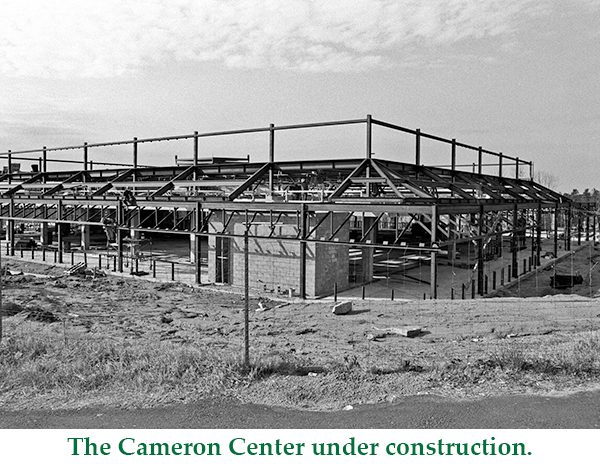
“Cameron was critical,” Coger said. “In terms of accessibility and in terms of hallway conversations it was a great thing. It was a little easier to find out what people were doing when you ran into them. It was a wonderful, fruitful environment. It made it easier to think about collaborations in different ways.”
Coger’s academic background included a bachelor’s from Cornell, a master’s and Ph.D. from UC Berckley, and post-doc research at Harvard Medical School. Her biomedical engineering research area involved solving problems associated with tissue engineering and the storage of cells, including low-temperature storage and cryopreservation.
At her UNC Charlotte interview, Coger met with Harshini DeSilva and Jim Oliver of biology. “I must say meeting with Harshini and Jim is what gave me confidence that we would be able to build something here,” she said, “and I was very excited about the potential and the opportunity to contribute to it. I think everyone who came to UNC Charlotte during that time period was excited by that potential for growth and the potential of influencing it, and I was no exception.”
There was fundamental support for the bioengineering group in terms of talented mechanical engineers who could build necessary devices and a strong chemistry department to do analysis work. But there were also a lot of growing pains for the group and university research overall.
“A lot of support things that people take for granted now didn’t exist then,” Coger said. “For instance we didn’t have electronic journals and had to use interlibrary loans. To stay current in your field was really hard then.”
The university didn’t have a central proposals and grants support systems, but fortunately the college of engineering had hired Toby Rufty in that role. “Toby was a critical in setting things up,” Coger said. “He was absolutely a life saver at that time.”
One of the first research grant successes of the group came in 2001, when the National Institutes of Health awarded $2.2 million over five years to UNC Charlotte for the establishment of the Bioengineering Research Partnership (BRP). There were three main research areas within the BRP, one researching oxygen transport within tissue engineered products, one involving micro-patterning to combine different cell types and as a result improve function, and one to develop machine perfusion techniques for lengthening the time in which a donated organ being transported could be preserved.
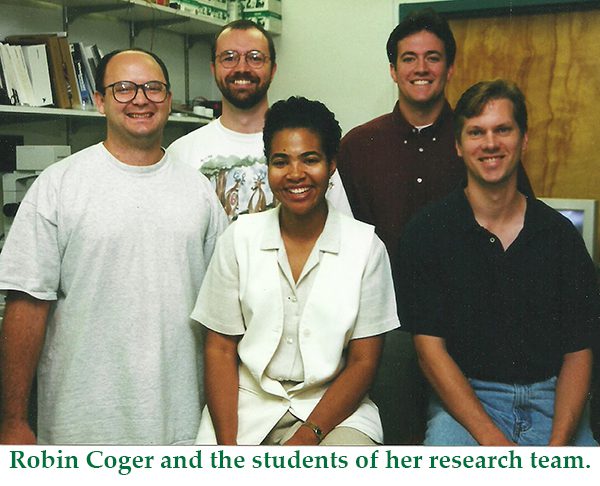
“One of the great things about that grant was the very nature of it meant our groups met together and met regularly,” Coger said. “When students presented their work it allowed others to see it, think about it and comment. It was a great thing for our students to learn how to communicate across disciplines.”
Based on the success of the BRP research, UNC Charlotte established the Center for Biomedical Engineering Systems (CBES) in 2005. Its purpose was to establish the infrastructure needed to continue strong interdisciplinary bioengineering research at the university. Coger was the first director of CBES.
“We built our leadership team and established focus areas, based on the people and their areas of interest,” Coger said. “We did a lot of planning the first year. Biology also moved into Woodward Hall at the same time in 2005, so we got some room for CBES.”
The three CBES research areas were Medical Therapies and Technologies, Biomechanics and Mobility Research, and Molecular Engineering and Design.
CBES succeeded in winning grants, building partnerships with groups such as Carolinas Healthcare System and Orthocarolina, and hiring new faculty. New engineering faculty included Gloria Elliott in the area of biological thermodynamics, Ahmed El-Ghannam in the area of bioceramics and Nigel Zheng in the area of biomechanics and motion studies.
After 15 years at UNC Charlotte, Coger moved on to North Carolina A&T in 2011 to become dean of engineering. “One of the things that I always thought was great about UNC Charlotte was we had some great people here,” she said. “Whether you’re talking about administrative, staff, faculty or students, I think we really had people who cared about the university. When you had that, you had and an experience I wouldn’t trade.”
As the new director of CBES, one of Lee’s first actions was to change its name from the Center for Biomedical Engineering Systems, to the Center for Biomedical Engineering and Science. “I wanted to change the name to include the biomedical science community,” Lee said, “so that’s why it became biomedical engineering and science.”
As CBES had grown, more and more researchers from outside engineering and biology became involved. Colleges collaborating on CBES research in 2012 included Health and Human Services, Liberal Arts and Sciences, Engineering, and Computing and Informatics. Outside organizations involved included the Levine Cancer Center, Presbyterian Hospital, CMC and the North Carolina Biotechnology Center in Kannapolis.
The research focus of CBES expanded to include more research on cancer such as working with the Levine Cancer Center to isolate leukemia stem cells, and in bio-nano technology to build medical devices such as brain-on-chips and cancer-on-chips.
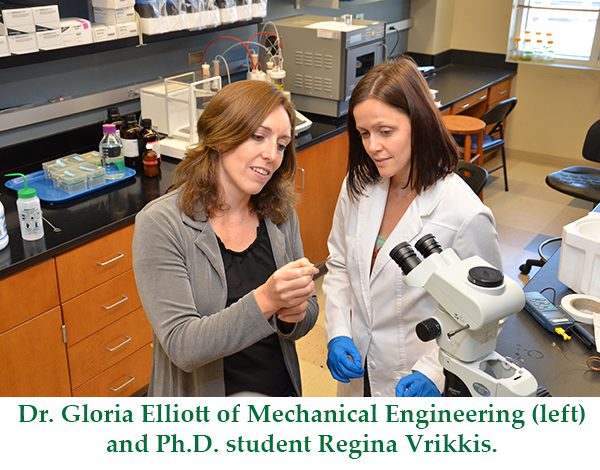
CBES was also successful over the years in generating spin-off companies. “There was definitely a spirit for translating the research from the bench top to clinical use,” Lee said. Examples include HepatoSys in the field of expanding availability of viable organs for transplantation through innovative engineering technology, SoyMeds in the development and validation of soybean seed-based therapeutics that could be used to treat, prevent, cure and diagnose diseases, and new companies in cancer therapy and diagnostics, and bioceramics for bone and drug delivery systems.
Engineering education was always an important part of CBES, as graduate students learned from working with faculty researchers. In 2015, Mechanical Engineering started the first bioengineering undergraduate program, offering a bioengineering concentration as part of the B.S. in Mechanical Engineering.
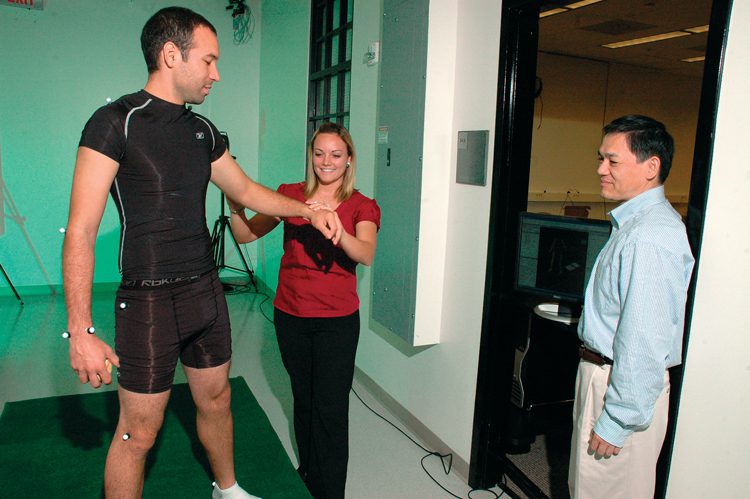
For the future, Lee said he was looking forward to number new opportunities. “The Levine Cancer Institute could become a major player in advancing cancer research. The core of CBES researchers could be involved and help in that cancer research, therapy and diagnostics. In the future we would love to establish academic degree programs in biomedical engineering at the graduate and undergraduate levels, which if successful would ultimately lead to a new department of bioengineering. I think we are going to make a major impact on the future of UNC Charlotte. I’m excited for the academic program, as well as for CBES.”